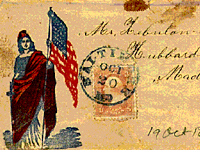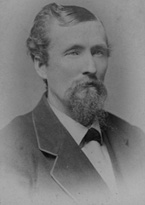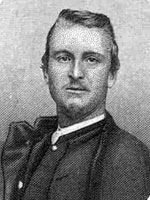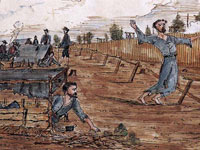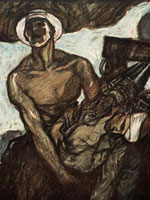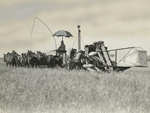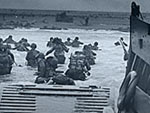Very few Civil War farmers went home to take care of the crops and then returned to fight. The American Civil War was far longer and more destructive than virtually anyone expected. At the outset of the war, many eager volunteers signed 90-day papers, evidence of the widespread belief that the war would be brief and nearly bloodless. Instead, the struggle stretched nearly four full years. Between 1861 and 1865, the Union and Confederacy mobilized more than three million men for the fighting and suffered some 600,000 deaths. The war remains the bloodiest conflict America has ever fought.
One of the reasons for the dramatic increase in the length of the war, the size of the armies, and the magnitude of the casualty rolls was the technological improvements in agricultural production that occurred in the decades leading up to the war. In the eighteenth century, the food demands of the population at large served as an important limit on the amount of manpower that could be mobilized into the army and on the length of time those armies could be maintained in the field. In those years, a nation that diverted a large proportion of its agricultural labor force to the military and kept it in the field for months at a time risked deprivation and starvation on the home front.
The war remains the bloodiest conflict America has ever fought
A bevy of technological improvements that appeared in the first half of the eighteenth century—iron and steel plows, seed drills, cultivators and, most importantly, mechanical reapers and threshers—made it possible to increase the amount of food that could be produced manyfold. By the mid-1800s, two men equipped with a horse and the new agricultural machinery could produce as much grain in a day as twenty men could harvest by hand using sickles in the late 1700s. Together, these changes dramatically altered the proportion of the population required for agricultural production. Three-quarters of American workers labored on farms in 1820; by 1860, fewer than three in five worked in agriculture.
The massive shift in the demographics of food production helps explain how the Civil War armies could place so many men under arms and keep them in the field for years on end. The massive armies that contested the huge battles between 1861 and 1865 could fight so long in part because their members were not needed at home to plant and harvest crops: the divisions could stay on campaign without threatening the larger society with starvation. And the substitution of mechanical advantage and animal effort for human muscle meant that farm labor no longer required adult men. Younger children and women could now perform many of the tasks that formerly demanded male workers. In the south, the labor of four million African-American slaves helped support the armies in the field and freed the white population to continue fighting. While neither side offered exemptions to farmers, the South did institute the Twenty-Negro Law, which released a plantation owner or overseer whom managed more than twenty slaves from military service—powerful evidence not just of slavery’s importance in maintaining the Southern economy and war effort but of the persistent fears of slave insurrection.
This is not to say that soldiers never returned to their homes and farms during the war. Furloughs for the troops were not uncommon, often doled out as a reward for service. (In the winter of 1863-1864, a Union Army desperate for reenlistments offered a 30-day furlough to any soldier willing to sign on for an additional three-year term.) But those furloughs rarely coincided with the agricultural cycle: campaigning season usually ran from the spring to late fall—precisely the months of planting and harvesting—and armies found it easiest to grant furloughs once the armies had gone into winter quarters. Soldiers generally viewed furloughs as a chance to visit loved ones and to escape the stifling discipline of army life for a brief moment.
Many soldiers elected to leave the ranks and return home to provide for their families, officially a capital crime in the eyes of the military system
In the South, the deprivations of war affected individual soldiers more acutely. Non-slaveholding white farmers—those who farmed small parcels of land for sustenance, as opposed to large planters growing cash crops—frequently joined the army in the belief that they were defending homes and families from Yankee invasion. As the war dragged on, and Federal troops pushed deeper into the Confederacy seizing crops and blocking transportation lines, many of those families suffered intensely from the scarcity of basic supplies. When letters arrived from home telling of wives, children, and siblings threatened with starvation, many of those rebel soldiers elected to leave the ranks and return home to provide for their families. Those desertions—officially a capital crime in the eyes of the military system—became more and more widespread in the last years of the war; historians estimate that as many as one in three Confederate soldiers had deserted by the final months of the war. Very few of those deserters returned voluntarily to continue the fight.


